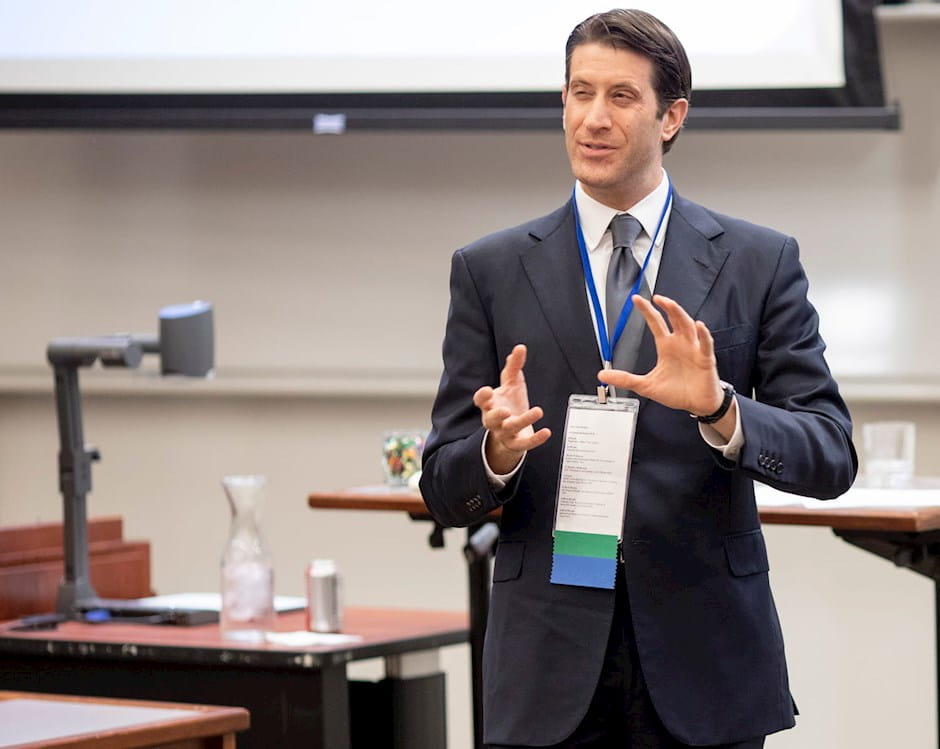
Professor John Paul Rollert taps into the tricky relationship between leadership and empathy and how to apply it in the real world.
- By
- April 12, 2019
- Leadership

How do you orient your empathic compass to engage people productively? That’s the question John Paul Rollert, Chicago Booth’s adjunct assistant professor of behavioral science, asked during the Rustandy Center for Social Sector Innovation’s On Board 2019 conference in Chicago.
The answer is far from straightforward, especially because empathy is subjective and based on personal experiences, he said. But having a better understanding of how empathy works allows leaders to tap into their own feelings to avoid pitfalls and produce better results when it comes to building relationships and leadership skills in the workplace or on a nonprofit board.
Rollert offered a few tips for building empathy during his “Booth in the Boardroom” session at the On Board nonprofit board service conference. Here are some takeaways:
Modern day workplaces make empathy difficult
The technical definition for empathy, or what Rollert describes as the “ability to step into someone else’s shoes,” is that it’s naturally easier to identify with people whose experiences are similar to your own. However, the world we live in today is more urban and diverse than ever, he said, noting the rise of urbanization and that nearly 80 percent of the US population lives in urban areas. “Part of the problem, when it comes to empathy, is that our experiences are different and understanding the world of someone else is not an easy thing to do,” he said.
Create your own community
Even if there are few commonalities from the start, organizations function best when colleagues can bond over shared experiences, he said. Working to strengthen these types of communities through professional development and other opportunities can build company culture. “Team building exercises at their best are creating a series of common experiences that build a community,” he explained. Ultimately, the focus on shared community experiences will help set expectations around how colleagues can act toward one another and create a culture of empathy within the organization.
Avoid empathy traps and blind spots
Once in a while, identifying with the feelings of your colleagues or workers you manage may put you at odds with what you need to do as a leader, he said. In some instances, you may feel others’ needs so deeply that pulling away and being less empathetic can be critical to succeeding in your own role. Sometimes you may need to disable your tendency to empathize. “Meaningful empathy might lead you to be pulled down by it,” he said.
One way leaders can apply empathy to company culture to succeed is by “having a good sense of what they don’t know,” Rollert said. Understanding which situations are less likely to elicit you own empathy can be critical to forging connections with others.
Honor your differences—and listen
Empathizing with colleagues is important, but understanding and sympathizing with them can be just as essential (and difficult). Luckily, it’s not always necessary to empathize in order to be a good leader. “Sometimes, understanding over empathy is the way to go,” Rollert said. Often times that means showing others kindness and generosity as you take a backseat to just listen to concerns, he said.
“Honor differences—you’re not attempting homogeneity,” to elicit empathy, he said. Rollert encouraged using the acronym PAL when sitting back to become a “Patient Accepting Listener.” Often times that means disabling your own judgment and reaction until you’ve heard what the other person is saying: “There should be a commitment to listening whether or not you achieve empathy,” he said.
John Paul Rollert led a “Booth in the Boardroom” session at the On Board conference on nonprofit board service on March 8, 2019, in Chicago. Hosted by Chicago Booth’s Rustandy Center for Social Sector Innovation, the sixth annual On Board conference in Chicago convened a crowd of nearly 300 Booth alumni and students and business and nonprofit leaders. Attendees learned key trends in nonprofit board service, gained insight from faculty into how research and other academic tools can be applied in the nonprofit sector, and connected with others looking to make an impact in the social sector.
Stay informed with Booth's newsletter, event notifications, and regular updates featuring faculty research and stories of leadership and impact.
YOUR PRIVACY
We want to demonstrate our commitment to your privacy. Please review Chicago Booth's privacy notice, which provides information explaining how and why we collect particular information when you visit our website.